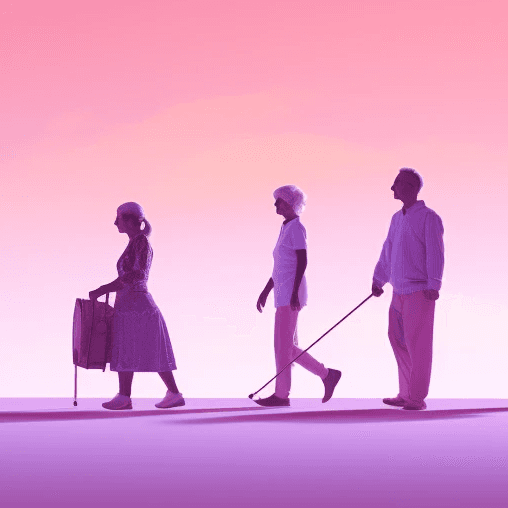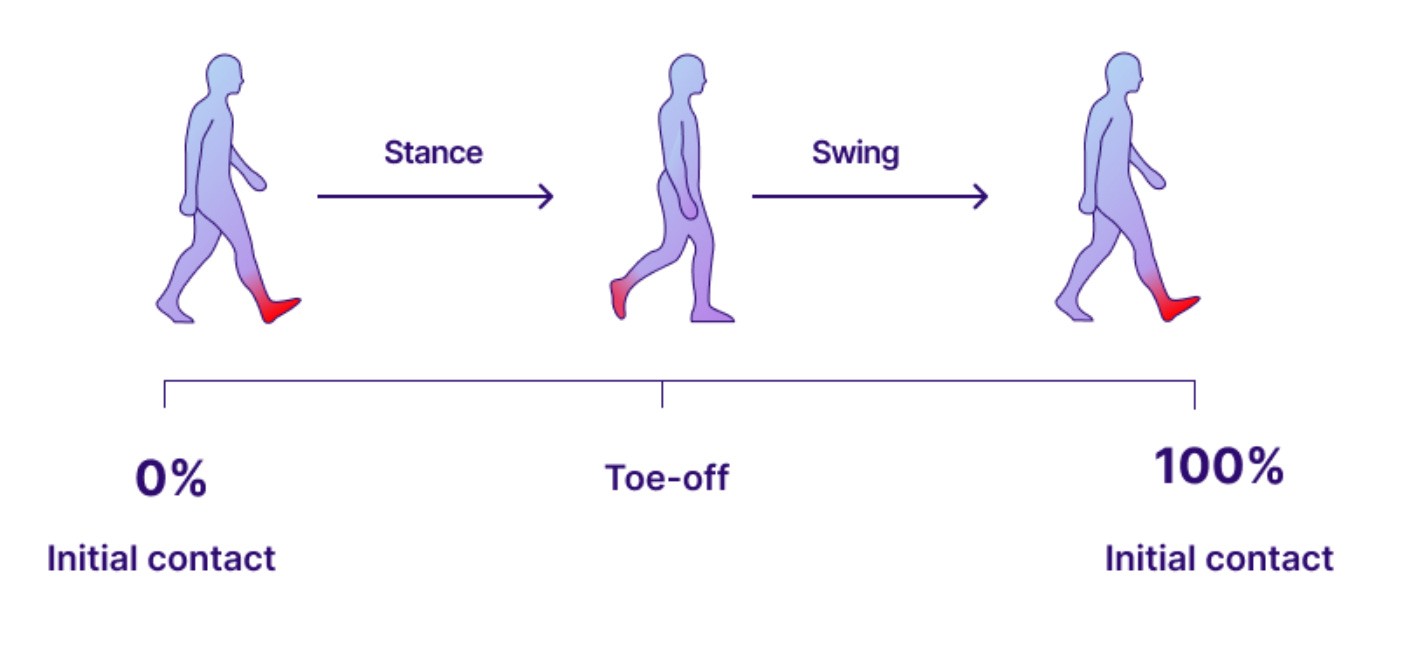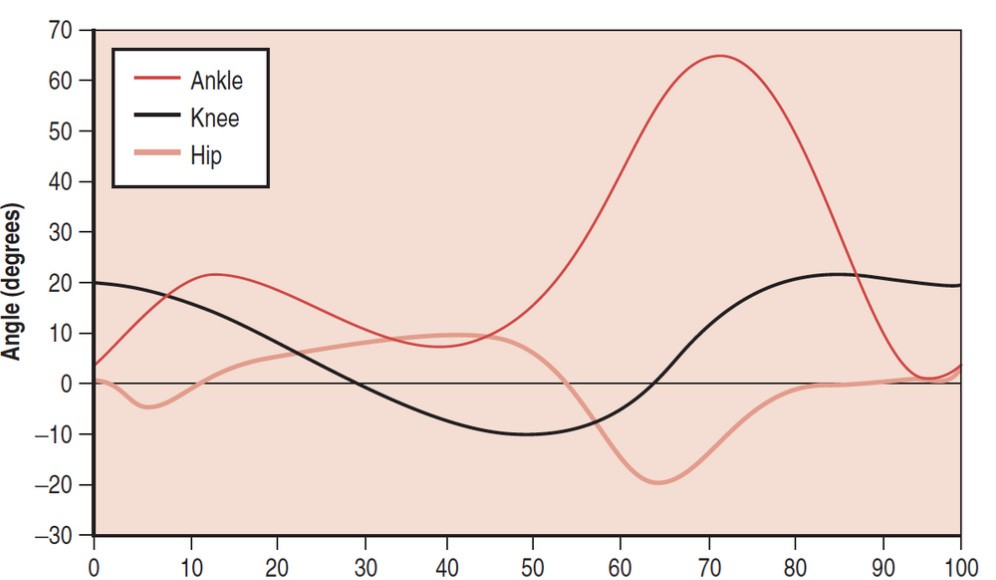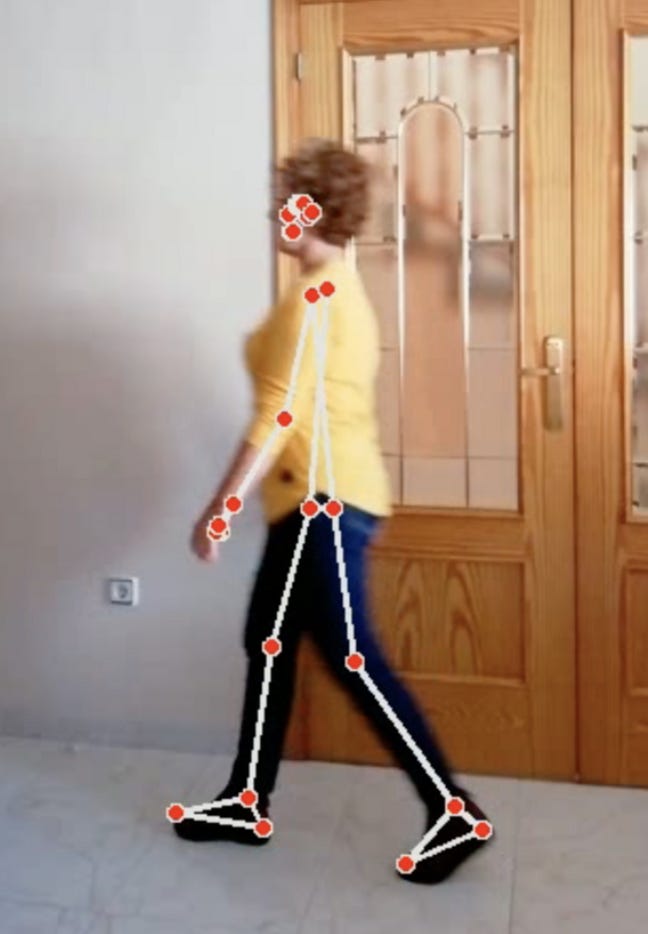Apr 25, 2022
Science

There is a movement we perform everyday that is so complex that it takes humans up to 7 years to learn. A movement that makes us unique among other species.
Gait is a biomechanical wonder we execute without even thinking about it, and one of the best health indicators that exist. We are going to give you some insights so you can better appreciate this daily movement and hopefully help you and your parents or grandparents stay healthier and live longer.
Let’s start from the beginning. Which is approximately 4 million years ago.
The invention of walking - History of bipedalism
Bipedalism is one of most important human evolutionary adaptations. Yes, adaptations. The truth is we cannot give the credit for inventing walking to only one of our hominid ancestors. Before our species was capable of walking on two legs, anatomical changes had been happening to their bone structure for millions of years. These anatomical changes affected particularly our spine, hip and pelvis, legs and feet.
“What is so cool about bipedalism?” Probably nothing. Just what made us unique among other primates: It gave us the ability to walk long distances while keeping our hands free [1-3]. Walking upright on two legs is the trait that defines the hominid lineage.
Development of gait
Gait has not only changed through history, but it also changes as we get older. Children start walking independently after 1 year, which is an important event in their psychomotor development as it gives them autonomy to move around their surroundings, increases their field of vision and allows them to grab and use objects that were previously not within reach [4].
However, this first walking attempt is not the same as a mature walk. Children have an insecure and unstable gait, with an evident lack of coordination. In order to compensate for this lack of balance, they walk with their feet widely separated and their upper limbs extended away from the body [4]. Children aged between 5-7 start to have an adult-like gait, and, until this moment, they have been experiencing with their musculoskeletal and neurological systems, until they achieve a complete neural control [4].
After this moment, gait continues changing throughout our lives, and that's why measuring gait has become an important biomarker of longevity. In order to understand this better, let’s see what is the gait cycle and its parts.
The Gait Cycle (GC)
One gait cycle (GC) includes two steps (or one stride), starting with the initial contact and finishing when that same foot contacts the floor again. The end of one cycle is the beginning of the next one [5].

At the beginning, the foot is in contact with the ground (stance phase), and then is lifted up in the air (swing phase). If we look at both feet, we can differentiate between the part of the cycle where both feet are on the ground (double support, DS) and when only one foot is in contact with the ground (single limb support, SLS) [5, 6, 7]. Actually this is the difference between walking and running: there is no DS phase when running, it becomes the flight phase. 80% of the time you are walking you are standing only on one foot!
It is also possible to subdivide the stance and swing periods in more specific functional divisions [8]. Remember we just said that you spend most of the time only on one foot? In order for one foot to rise from the floor (swing phase), the weight must be supported entirely by the other foot. Therefore, your body weight changes continuously from one foot to the other. One foot has just contacted the floor and suddenly boom, the responsibility of holding your whole weight is suddenly on them. This corresponds to the loading response phase.
Before starting the swing phase, the body needs to adapt to prepare for the weight shift (again). Weight is transferred rapidly to the contralateral limb in order to unload the ipsilateral limb and prepare it for the swing.
In the initial swing, flexion of hip, knee and ankle allow you to raise the leg and avoid you to bump over any obstacle on the floor (next time you trip, you know who to blame now). In mid-swing, hip and knee extension produces the swinging limb to move forward. Finally, at the terminal swing, the heel contacts the floor and the knee extends, allowing you to move forward.
Congratulations! You just gave two steps! And you do that all over and over and over. Assuming you want to move forward (rather than in circles), it is worth noting that you do not only move in this direction. Every time you “just walk”, you are moving your body simultaneously in three directions! [9].

Remember that weight shift we talked about? Because of this shift, the center of mass of your body (CoM) moves from side to side
Also, the CoM moves upwards to allow your limb to swing, and then downwards to prepare for the heel contact.
And, obviously, forward.
And again... you do all of that in spite of being 80% of the time only on one foot (actually, it is not in spite of, but thanks to). As you can imagine, this requires a notorious stability and motor control [9].
Remember when we told you that you knew now who to blame next time you trip over a simple wire? The study of hip, knee, and ankle angles can be used as an estimation of your risk of falling. A decreased flexion of those joints can make your swinging leg not to rise enough, so your foot may impact with the floor or a step.
But don’t think only your lower limbs are the ones to acknowledge for this biomechanical wonder which most of us call walk. The movement of the arms and shoulders is used to counteract the rotation of the trunk produced by the swinging of the leg, hence participating in maintaining stability during gait [10].
Gait Problems. What does your gait say about your health?
The amount of time you spend on SLS is different between your right and left leg? You probably have a joint injury on the leg you (maybe unconsciously) try to avoid supporting your weight for a long time, which can be a torn meniscus, sprained ligaments, or arthritis.
Do you waddle from side to side, instead of walking straight? That is a sign of muscle weakness, particularly your gluteal muscles.
And it doesn’t stop here. Gait is not only a reflection of your musculoskeletal system. Or haven’t you ever noticed how happy somebody was just by the way they walked? And not only psychological aspects, but also neurological ones. If your feet don’t lift enough and don’t go through the full heel-to-toe range of motion, that could be indicative Parkinson’s disease [11].
At Rosita, because we work with seniors, we care in particular about measurements that are important to them because they can be predictive of frailty, a chronic disease that affects 49% of seniors (7% frail and 42% prefrail) and which is the leading indicator of dependency, loss of autonomy and an unhealthy longevity. Society does not often speak of frailty, but it is a real epidemic that affects many families with a dramatic impact in their lifestyles for those years. That's why we are working hard to find ways to predict it, prevent it, AND revert it. Let's dig in:
Gait analysis for Frailty
Different studies agree on finding that gait in elders is characterized for having a reduced gait velocity, step length, and SLS time when comparing them with young subjects[12]. In other words, slow shuffling gait with short steps. These changes appear due to a loss of muscle strength (sarcopenia) and balance. Weaker leg muscles have as a result a reduced flexion of hip, knee and ankle that makes the feet to not elevate that much from the floor during the swing phase, hence increasing the risk of bumping into any obstacle and falling (which can have critical results for elders). This reduced joint flexion can also appear as a consequence of pain due to osteoarthritis.
Additionally, because of the loss of muscle strength and control, balance is also worse. As a result, frail elders try to reduce the time you spend only on one leg to the minimum, and consequently they spend longer time in double support.
Particularly, gait speed is a particularly interesting parameter as it has been shown to be associated with survival, hence being a good indicator to reflect functional status, mobility limitations, and overall health. Using gender, age and gait speed, it was possible to estimate predicted years of remaining life, which increased as gait speed increased. The hypothesis behind this is that changes in gait can be an early sign to identify pathological processes, even before other clinical manifestations appear [13 - 16].
To give you a scary number, a gait speed of less than 0.8 meters per second is associated with a risk of death of 30% within 12 months! Additionally, gait mechanics are more predictive of dementia than any cognitive test.
If you are above 60, or you have parents and grandparents, you should keep track of their gait to avoid risk of frailty. The good thing is that it can be trained and improved. You need strength and balance.
How to Measure my main gait biomechanics? Know your gait
There are biomechanical laboratories with all the fancy equipment you can imagine: platforms to measure pressure and power, multiple complex cameras for motion capture, infrared cameras and markers, electromyography systems to measure muscle activity, and so on. We have used some of those with our partners at the Biomechanics Institute of Valencia.
However, one of the simplest (and cheapest), most used clinical procedures is Observational Gait Analysis, where gait deviations are identified merely using visual observations. To perform this analysis, clinicians need to have a lot of knowledge and experience. However, human knowledge has a limitation: time. Learning is a slow process which goes on for years.
Fortunately, technology does not share human limitations. It would take over 40 years for an experienced radiologist to look at approximately 225,000 MRI/CT exams, whereas an AI (Artificial Intelligence, a machine with human-like intelligence) can do it in seconds.
In Rosita we work everyday to bring technology and science closer to you, and we could not miss the opportunity to bring you the tool for frailty analysis.
Gait analysis in Rosita. How do we predict frailty by watching you walk
Gait analysis is an excellent tool to assess one’s clinical condition, because it is a very “simple” exercise to perform (no expensive material needed) and it is a good indicator of both musculoskeletal and neurological functions.
In Rosita, we have been working in cooperation with the Instituto de Biomecánica de Valencia (IBV) to design a diagnostic gait analysis test using artificial intelligence in the home environment. Users are only asked to do one thing: record themselves walking.
With just a recording of a user walking, we can put our AI algorithm to work. The AI is trained to detect different key points of the body, including several face points and main joints. Up to 33 anatomical points can be detected in a whole body image.
Now that the AI is capable of following as you walk, the position of your joints in time can be calculated, from where your joint angles can be calculated. With this information we can obtain your risk of falling and your legs’ muscle strength, seeing if you raise enough your leg during the swinging phase or if, on the contrary, you shuffle your feet.
By obtaining these parameters for both your leg and right legs, it can be used to find unilateral impairments that may be due to osteoarthritis at a certain joint or even a sign of a post-stroke hemiplegic gait.
Additionally, we calculate the vertical displacement of your CoM to see how well the leg in contact with the ground during SLS phase manages weight acceptance and weight transfer to the other leg, this being another indicator of your muscles strength and joint health.
Moreover, using your height we are capable of measuring the distance covered in the video, and calculate your gait speed. As explained in previous sections, gait speed alone is a magnificent indicator of your overall health because other impairments in other parts of the body will reflect on your gait speed. Combining it with the other calculated parameters (CoM displacement and joint angles), we are capable of performing a complete gait analysis.
Here you can see an example of one of our users, a graph with the angles of flexion and extension that one of her joints performed.


Okay the analysis is ready, but what does it say about my health?
Well, since there is a direct correlation between frailty (and pre-frailty) and risk of death, depending on the quality of your walking biomechanics, it is possible to predict your frailty or robustness, and hence create longevity biomarkers based on gait.
In Rosita we don’t believe that aging and becoming frail always go together. Is your walking biomechanics poor, you barely lift your feet from the ground, and you are incapable of taking longer strides because you lose balance? Is that an inevitable consequence of becoming older and losing strength?
Short answer: NO. It is actually the other way around: You feel old because you have not been working out to maintain your strength.
Frailty and aging don’t necessarily go together. Rosita is here to help you reverse this situation. As of Feb 2022, the tech above is still under development but we hope to make it available inside our App within a few months.
Is walking the solution to obtain better walking mechanics?
If your gait mechanics is poor... should you walk for hours everyday? Again: NO. Walking is an important activity and we would all benefit from walking more everyday. If right now the amount of physical activity you perform every day is close to zero, then walking is a good start to push healthier habits forward. But walking is not enough.
Let’s go back to our blood sample test analogy. Trying to fix walking by walking is like trying to get better results in the blood test by getting a transfusion. A bad result in a blood sample test may indicate that you should check some of your habits, such as nutrition. With gait analysis, it is the same, it is not only that your waking mechanics are poor, it means that your overall physical status is frail.
No matter where you start or your current physical status. Strength training is for anyone, you just have to find the level that is adequate for you. Strength training can be starting from your highest chair and using your arms to lift you up, and try to do as many repetitions as you are capable of, even if it's 2! By doing it every day, you will see how you start adding more repetitions, using lower chairs, not needing your arms to assist you anymore... As your strength increases, your overall health (and yes, your gait mechanics) will improve considerably. Quiz time... Do you think a walking aid would help you achieve that?
You may not believe this is possible. It is not a matter of believing, it is a matter of facts. Like one of our users that told us after 3 months with us she has been capable of getting out of bed by herself for the first time.
Longevity Insights: Keynotes from Gait Analysis and specific tips:
Even though walking is a daily activity we perform all the time without consciously thinking about it, it is a biomechanical movement of high complexity. Thanks to this complexity, gait analysis represents an excellent tool to evaluate not only musculoskeletal functions, but also the neurological system. Different studies that have followed up different seniors until their death, have found a direct correlation between gait speed and predicted years of remaining life. Therefore, a good estimation of lifespan can be calculated only using gender, age and walking speed.
Not only can the risk of death be calculated, but also walking speed is a good indicator of risk of falls, hospitalization, need of a caregiver, fractures, nursing home admission, among others. This is because a decrease in walking speed is thought to be an early indicator of other conditions. Due to its potential as an early diagnosis tool and its simplicity, gait analysis represents an amazing test to assess frailty.
Even though walking is a very important activity with multiple benefits, just walking is not enough. In order to improve our health and see how it reflects in our walking mechanics, strength training is fundamental. No matter your current situation, there is always some strength training you can perform. The point is not suddenly becoming a weightlifter at 75, but being stronger than you were when you were 74.
We are doing our part by creating a test that uses artificial intelligence techniques in video to analyze your gait and to assess your overall health condition. By performing this test regularly, it is possible to detect early deterioration of our well-being even before other clinical outcomes appear. The personalized training plan we offer in Rosita is adapted to your current situation no matter what that is. Thanks to tests like the gait analysis, we are capable of understanding where you are right now, offer you the best training and measure your progress.
Being able to escape from the grips of frailty and increase your healthspan is within your reach, and a responsibility you or your loved ones should take care of.
From Rosita we are here to help. See you soon!
References
J. Farris, L. A. Kelly, A. G. Cresswell, and G. A. Lichtwark, “The functional importance of human foot muscles for bipedal locomotion,” Proceedings of the National Academy of Sciences, vol. 116, no. 5, pp. 1645–1650, Jan. 2019, doi: 10.1073/pnas.1812820116.
L. T. Gruss and D. Schmitt, “The evolution of the human pelvis: changing adaptations to bipedalism, obstetrics and thermoregulation,” Philosophical Transactions of the Royal Society B: Biological Sciences, vol. 370, no. 1663, p. 20140063, Mar. 2015, doi: 10.1098/rstb.2014.0063.
W. Wang et al., “Comparison of inverse-dynamics musculo-skeletal models of AL 288-1 Australopithecus afarensis and KNM-WT 15000 Homo ergaster to modern humans, with implications for the evolution of bipedalism,”Journal of Human
S. Collado Vázquez, “Desarrollo de la marcha,” Revista de la Facultad de Ciencias de la Salud - Universidad Alfonso X el Sabio, 2005.
C. Kirtley, “The temporal-spatial parameters,” in Clinical Gait Analysis: Theory and Practice, Elsevier Health Sciences, 2006.
T. Yuan et al., “The mental representation of the human gait in young and older adults,” 2015, doi: 10.3389/fpsyg.2015.00943.
F. M. Chang, J. T. Rhodes, K. M. Flynn, and J. J. Carollo, “The Role of Gait Analysis in Treating Gait Abnormalities in Cerebral Palsy,” 2010, doi: 10.1016/j.ocl.2010.06.009.
J. Perry, Gait Analysis: Normal and Pathological Function, 1st ed., Downey, CA: SLACK Incorporated, 1992.
L. Tesio and V. Rota, “The Motion of Body Center of Mass During Walking: A Review Oriented to Clinical Applications,” Frontiers in Neurology, vol. 10, Sep. 2019, doi: 10.3389/fneur.2019.00999.
M. L. F. Ballesteros, F. Buchthal, and P. Rosenfalck, “The Pattern of Muscular Activity During the Arm Swing of Natural Walking,” Acta Physiologica Scandinavica, vol. 63, no. 3, pp. 296–310, Mar. 1965, doi: 10.1111/j.1748-1716.1965.tb04069.x.
Reader's Digest Australia. (n.d.).What your walking style can reveal about your health. Retrieved February 24, 2022, from https://www.readersdigest.com.au/healthsmart/what-your-walking-style-can-reveal-about-your-health#:~:text="Your gait reveals a lot"&text=Then we develop a newfound,Schwartz%2C a physical therapy specialist.
C. A. McGibbon, “Toward a Better Understanding of Gait Changes With Age and Disablement: Neuromuscular Adaptation,” Exercise and Sport Sciences Reviews, vol. 31, no. 2, pp. 102–108, Apr. 2003, doi: 10.1097/00003677-200304000-00009.
S. Studenski, “Gait Speed and Survival in Older Adults,” JAMA, vol. 305, no. 1, p. 50, Jan. 2011, doi: 10.1001/jama.2010.1923.
M. Montero-Odasso et al., “Gait Velocity as a Single Predictor of Adverse Events in Healthy Seniors Aged 75 Years and Older,” 2005, Accessed: Feb. 02, 2022. [Online]. Available: http://biomedgerontology.oxfordjournals.org/